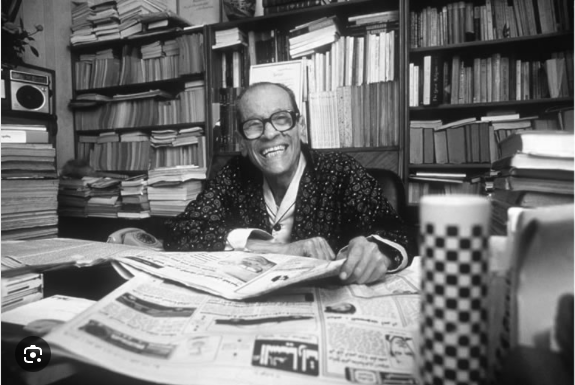Naguib Mahfouz: A Neighborhood’s Diarist as a Nobel Prize Winner

By: María Teresa Fidalgo-Azize/ Arab America Contributing Writer
Ladies and gentlemen, you might be wondering how a man from the third world found the peace of mind to write stories. Well, you are perfectly suitable. I come from a world burdened by debts, and paying them back could lead to starvation or something very close to it. This sentiment is echoed in Naguib Mahfouz’s Nobel Prize Literature Acceptance Speech in Stockholm 1988.
Naguib Mahfouz, the universally acclaimed chronicler of Egyptian society and novelist behind the Arab literature magnum opus, “The Cairo Trilogy,” chose not to travel to Sweden in 1988 to receive the Nobel Prize after more than five decades of a prolific writing career. In his own words, he stated that “even a two-week trip would disrupt my lifestyle.” His general aloofness toward Western validation is evident in his acceptance speech, which writer Mohammed Salmawy read. Instead of self-aggrandizement, Mahfouz called on the internationally powerful to address global oppression, such as the occupation of Palestine and apartheid in South Africa. Born from the happy marriage of two civilizations—Pharaonic and Islamic—Naguib Mahfouz trailblazed the literary genres of the novel and the short story, rooted in a universalist spirit defining Egyptian identity before and after the revolution of 1952.
In Mahfouz’s works and film adaptations, including “The Cairo Trilogy,” “The Thief and the Dog,” “Children of Our Alley,” and his recently discovered eighteen short stories in “The Quarter,” he voices unheard existentialism through the labyrinth of the Egyptian soul. Like all great men, he risked his life to speak.
The Quarter Stories
The search went on for several days but without success. All that was clear was the people’s apathy and ill will toward each other and their lack of confidence in the authorities and the law. When those in touch with the visible world could not quench the thirst for truth that people were feeling, those connected to the unseen volunteered to reveal the unknown, as depicted in Naguib Mahfouz’s “The Arrow.”
Throughout the eighteen short stories, the literary themes of poverty, deprivation, unplanned pregnancies, a quarter cursed by a zar, indigent vagrants, and the sometimes-depicted unfair administrative rule are all infused with comedic relief and compassionate empathy. This empathy extends to vile characters and the ideology and social framework that guide them. Mahfouz’s study of Sufism, a mystical movement within Islam, influenced his portrayal of Islam, transcending from the social ruling structure of organized religion to one of spiritual guidance. Regardless of Mahfouz’s mundanely formatted prose, his writing allows for a subtextual reading into the intricacies of Egyptian political life.
In the short story “The Arrow,” the main plot discusses a moral plague tormenting the quarter where a crime is committed in broad daylight. A man’s murder provokes apathy and annoyance from the rest of the people in the quarter. The quote expresses the lack of confidence in authority, reinforcing the public’s inclination toward superstitious beliefs. Mahfouz’s crafted absurdism regarding how an arrow killed the victim of the murder that no one can precisely trace showcases his fascination with the non-logical worldview of society, which exists solely within an emotional folkloric core.
Conclusion
Naguib Mahfouz articulates a cosmogonic view of life in the quarter in Egypt’s Cairo. Despite the elements of class and social hierarchies, there is an overwhelming sense that all its inhabitants still encompass one plural experience as Egyptians. There is a sentiment of oneness to the Egyptian identity. In the short story “Bad Luck,” the ending lines between a widowed, wealthy man and his coveted servant express a desire for connection—human empathy trespassing man-made barriers. The beauty of Mahfouz’s storytelling in the short story collection “The Quarter” lies in his refusal to choose the static inertia of cynicism and pessimism when describing society. Instead, one witnesses his sublime incantations of cautious hope: unity.
Works Cited:
Aydin, Özlem. “Historical Allegories in Naguib Mahfouz’s Cairo Trilogy .” Bingöl University Journal of Social Sciences Institute, vol. 4, no. 8, 15 Oct. 2014, pp. 127–138.
Interviewee Mahfouz, Naguib. “The Art of Fiction No.129.” Interviewed by Charlotte El Shabrawy. The Paris Review. Issue 123, Summer 1992. https://www.theparisreview.org/interviews/2062/the-art-of-fiction-no-129-naguib-mahfouz
Mahfouz, Naguib. The Quarter. Translated by Roger Allen, Saqi Books, 2009.
McFadden, Robert D. “Naguib Mahfouz, Chronicler of Arab Life, Dies at 94.” The New York Times, The New York Times, 30 Aug. 2006, www.nytimes.com/2006/08/30/books/31mahfouzcnd.html.
Poljaveric, Emin. “ Egypt, Revolution of 1952”. International of Encyclopedia of Revolution and Protest. 2009. pp.107-109.
Check out the Arab America blog here!!
[1] In 1994, a religious extremist stabbed Naguib Mahfouz in the neck outside his home in Cairo, leaving him with permanent damage to his right arm, which slowed down his writing process.
[2] “A zar is associated with evil spirits and a set of reconciliation rites between the spirits and their human roots”. (El Hadidi, Hager)









